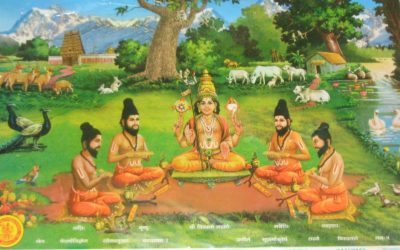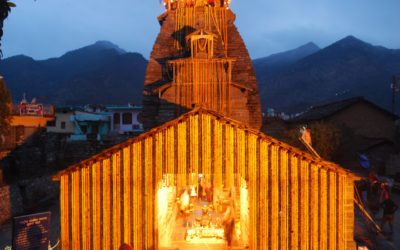In the village of Trimbak, in the Nashik district of Maharashtra, is the ancient temple town of Tryambakeshwar. Tryambakeshwar is the place where Mahadev Himself appeared as a light shaft, assuming form as a jyotirlinga. Sage Gautam once accidentally committed the sin of killing a cow. As an act of repentance, he performed penance at the peaks of the Brahmagiri Mountains, appeased Lord Shiva and asked for the Ganga waters so that he could wipe off his sin.
Legends
Pleased with his devotion, Lord Shiva jerked His matted locks on the Brahmagiri Mountains and sent Ganga down onto the earth. Today that place is known as Gangadwar, situated halfway to the Brahmagiri Mountains. There is a temple of Ganga there, known here as River Godavari. Ganga appears for the first time here, after which it vanishes. As the flow of the Ganga was tremendous, the sage could not bathe in her waters. He then surrounded the river with kusha, a type of grass, and reduced the flow. After bathing here his sin of killing a cow was finally wiped off. It is one of the holiest place to perform the shraada ceremony (ritual to pay homage to ancestors/departed souls).
Tryambakeshwar Temple
The Tryambakeshwar Temple contains the jyotirlinga which is extraordinary in several ways. It embodies all three Trimurti together: Lord Vishnu, Lord Brahma and Lord Shiva. The linga comprises of three small, thumb-like lingas, each representing one of the Trimurti. They are svayambhu, or self-manifesting. The three lingas are covered with a kavacha (metal covering), usually of silver, which bears the faces of the Trimurti. On special occasions a gold kavacha is worn, and upon this a jeweled crown is placed. The crown, covered in precious gems, is from the age of the Pandavas.
Tryambakeshwar is the only jyotirlinga where the lingam sits in a depression on the floor. Consequently, the tri-linga in the sanctum is not worshipped with abhisheka in the usual way. The linga of Shiva has a constant stream of natural Godavari water flowing over it. The Kushavarta Kund inside this temple is considered to be the symbolic origin of the Godavari. The current structure of this temple is the result of a reconstruction effort by Peshwa Balaji Bajirao (Nanasaheb), in the mid-18th century.
Anjaneri is a mountain seven km from Tryambakeshwar. It is the birthplace of Lord Hanuman. On the southeast corner is the temple of Kedareshwar Mahadev, who in disguise of Kedarbhatta made Gautam bathe in the waters and absolved him from the sin of killing a cow. This pond was created by Pandavas.
The water of Gautami Ganga or Godavari comes from Brahmagiri mountain and gets stored here and from here the river goes towards the main Tryambakeshwar temple. The miracle is that nobody knows from where the water arrives here in the pond. This pond is always full with the Godavari water, never dries up and nobody knows from where the water leaves the pond to form the river.
The Simhastha Kumbh Mela
Once in 12 years, Tryambakeshwar becomes the location of the greatest and grandest celebration of Hinduism – the Kumbh Mela. Called the Simhastha Kumbh, it occurs when planet Guru or Jupiter enters and resides in the zodiac house of Simha or Leo for an entire year. During these celebrations, lasting an incredible 72 days, all the heavenly gods, and Enlightened Masters of Hinduism, Buddhism, Jainism and Sikhism descend on Tryambakeshwar to witness and bless the humongous gathering of pilgrims and devotees. This is especially on the five dates of the snan or holy dips in the Godavari.
Tryambakeshwar “is the place where the greatest being walked on the planet Earth and decided to live there for years to celebrate his light romance with his consort Sita, the great Lord Ram. He chose that place because all the sapta rishis of that time were living there. And all the great five energies were available there. That is, the energy of earth, water, fire, air and ether. All the five were very auspicious in that place called Panchavati. That is why Lord Ram chose that place to spend with Sita.” – Paramahamsa Nithyananda
(reproduced from Nithyananda Times, October 2015)





0 Comments